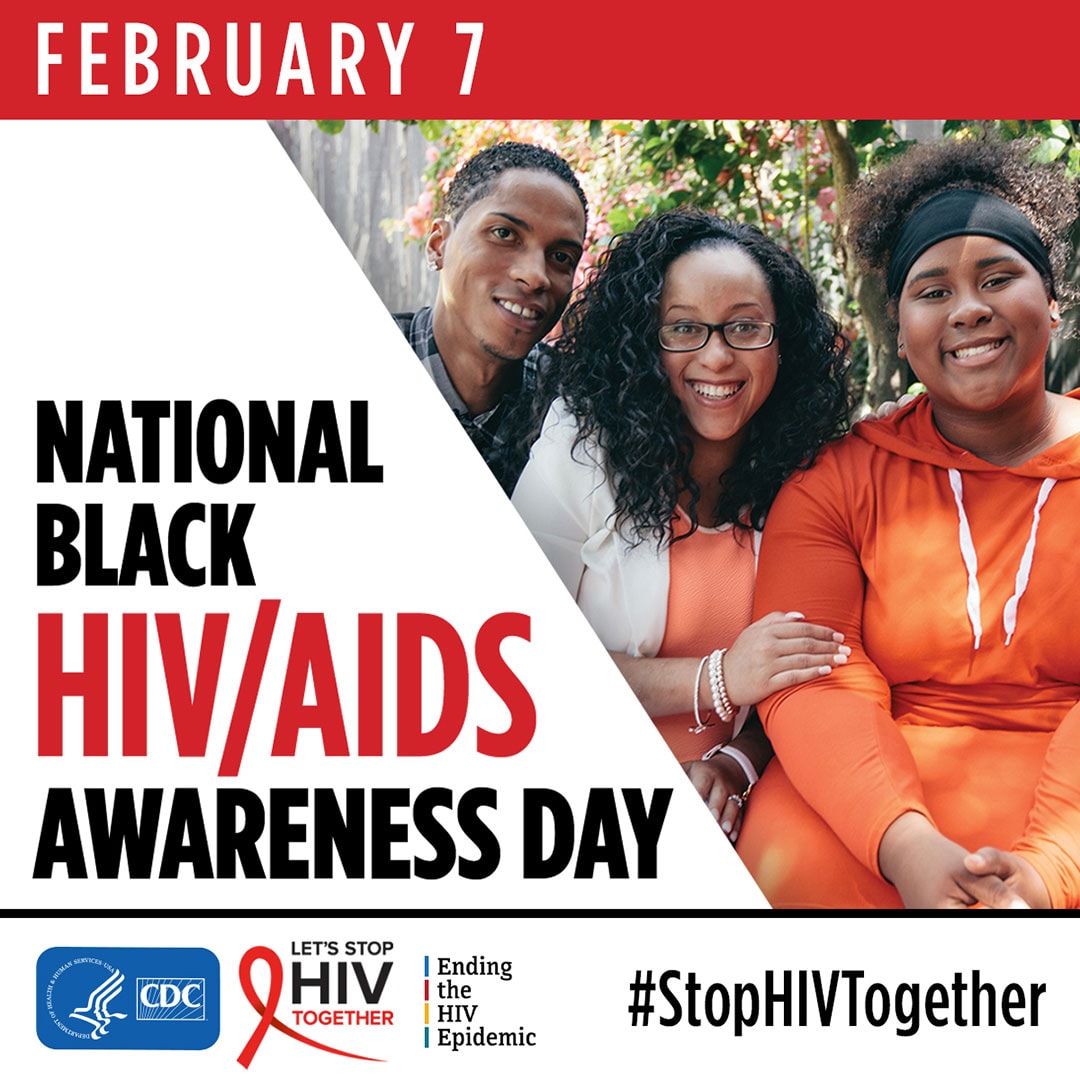Dear Colleague: We’re in This Together
Cross-posted from Centers for Disease Control and Prevention

Dear Colleague:
The 2020 National Black HIV/AIDS Awareness Day (NBHAAD) theme, We’re in This Together, emphasizes the importance of support from friends, family, colleagues, and partners. Social support is especially important because its potential to mitigate the negative impact of ongoing health disparities and stigma. On February 7th and every day, we can get involved in prevention efforts, get tested, get treatment if we have HIV, and use prevention tools such as pre-exposure prophylaxis (PrEP) and condoms if we do not.
Blacks represent 13% of the U.S. population, yet make up 43% of new HIV diagnoses. The most recent HIV diagnoses data show decreasing disparities for some groups, but inequities remain. From 2010 to 2017, HIV diagnoses:
- decreased 15% among blacks overall;
- decreased 27% among black women;
- decreased 32% among heterosexual black men;
- were stable among gay and bisexual black men overall, but varied by age.
Limited access to services, stigma, discrimination, poverty, and homophobia place some African Americans at higher risk for HIV. The poverty rate is higher among African Americans than other racial/ethnic groups, and the socioeconomic issues associated with poverty—including limited access to high-quality health care, housing, and HIV prevention education—directly and indirectly increase risk for HIV infection.
We can, and must, do better.
Goals we once thought impossible are well within reach, but eliminating racial disparities is critical. Despite the game-changing developments in HIV prevention and treatment tools, not everyone is benefiting equally from these advances. A recent CDC report showed that from 2010 to 2017, fewer blacks, compared with whites, were linked to HIV medical care within 90 days of diagnosis, retained in care, or virally suppressed.
The HHS Ending the HIV Epidemic: A Plan for America (EHE) Initiative is a bold effort to reduce new HIV infections by 90% by 2030. The initiative significantly increases resources, technology, and expertise where they’re needed most—and it will decrease disparities. Phase 1 of the EHE initiative focuses on 48 counties, Washington, D.C. and San Juan, Puerto Rico, that together account for more than 50% of new U.S. HIV diagnoses, and seven states that have a substantial rural burden of HIV. Nearly two-thirds (62%) of new HIV diagnoses in 2017 for black/African Americans were in the 57 EHE phase 1 jurisdictions.
CDC is working on all fronts to improve access to testing, overcome barriers for linkage to and retention in care, increase access to PrEP, and reduce new infections and HIV-related disparities. For example, CDC is focused on using the latest systems and technology to make testing truly routine in healthcare facilities that are likely to engage people at risk for HIV who otherwise have limited access to healthcare. CDC is working with grantees, partners and providers to ensure immediate—ideally same-day—linkage to care for people with a new diagnosis of HIV and linkage to PrEP services for those at risk but who do not have HIV. And to help increase PrEP uptake, HHS has launched Ready, Set, PrEP, a nationwide program that makes PrEP medications available at no cost to individuals who qualify and lack prescription drug coverage. Eligibility requirements and an explanation of how the program works are available at GetYourPrEP.com and 1-855-447-8410.
This year’s theme, We’re in This Together, emphasizes the importance of social support—from friends, family, colleagues, and partners. We call on everyone to use our digital toolkit with resources from CDC’s Let’s Stop HIV Together campaign to combat HIV-related stigma and end the HIV epidemic in America. We encourage you to create and share social media content using the #StopHIVTogether and #NBHAAD hashtags. Each of us has a role to play:
Healthcare providers can
- Routinely screen all patients.
- Provide HIV treatment as soon as possible after diagnosis.
- Prescribe PrEP using CDC’s guidelines.
Health departments can
- Expand HIV testing to include testing at home and other nonclinical settings.
- Strengthen HIV care and peer support networks to improve HIV treatment.
- Increase PrEP usage in communities that need it the most.
Everyone can
- Get tested for HIV, STDs and hepatitis.
- Use the HIV Risk Reduction Tool to better understand HIV.
- Talk with healthcare providers about HIV prevention, including condoms and PrEP.
- Encourage friends and loved ones to stay healthy by taking medicine if they have HIV or are on PrEP.
CDC is committed to ending the HIV epidemic in the United States for everyone. On this day and every day, we ask that you join us by fighting HIV-related stigma and promoting HIV testing, prevention, and treatment. It has been a long road and we have come so far. We know we can reach our goals because, as a nation, we are in this together.
Sincerely,
/Eugene McCray/
Eugene McCray, MD
Director
Division of HIV/AIDS Prevention
National Center for HIV/AIDS, Viral Hepatitis, STD, and TB Prevention
Centers for Disease Control and Prevention
/Jonathan Mermin/
Jonathan H. Mermin, MD, MPH
Rear Admiral and Assistant Surgeon General, USPHS
Director
National Center for HIV/AIDS, Viral Hepatitis, STD, and TB Prevention
Centers for Disease Control and Prevention